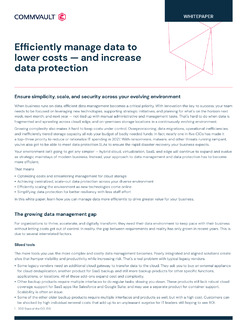When business runs on data, efficient data management becomes a critical priority. With innovation the key to success, your team needs to be focused on leveraging new technologies, supporting strategic initiatives, and planning for what’s on the horizon next week, next month, and next year — not tied up with manual administrative and management tasks. That’s hard to do when data is fragmented and sprawling across cloud, edge, and on-premises storage locations in a continuously evolving environment.
Growing complexity also makes it hard to keep costs under control. Overprovisioning, data migrations, operational inefficiencies, and inefficiently tiered storage capacity all rob your budget of badly needed funds. In fact, nearly one in five CIOs has made it a top-three priority to reduce or rationalize IT spending in 2021.1 With ransomware, malware, and other threats running rampant, you’ve also got to be able to meet data protection SLAs to ensure the rapid disaster recovery your business expects.
Your environment isn’t going to get any simpler — hybrid cloud, virtualization, SaaS, and edge will continue to expand and evolve as strategic mainstays of modern business. Instead, your approach to data management and data protection has to become more efficient.

